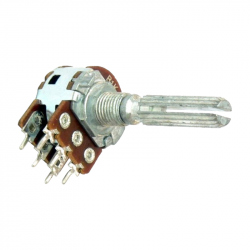Dupa plasarea solicitării de comandă, in sectiunea Istoric puteti vedea cate solicitări de comandă mai avem de procesat inaintea dumneavoastra
Program de lucru: Luni - Vineri 9:00 - 18:00, pauza 13:00 - 14:00.
Se efectueaza lucrari de mentenanta la site si pot aparea erori. In cazul in care intampinati erori va rugam sa reincercati mai tarziu.
Ridicarea personala este disponibila pentru comenzile achitate in avans. Se pot ridica dupa ce sunt pregatite.
Niciun produs
 Mărește
Mărește
Driver pentru Motor DC cu Perii DRV8801
0104110000020147
Produs nou
Acest driver permite controlul bidirecțional pentru motoare cu perii DC - Tensiuni: 8V - 12V. Curent: 1A.
2 bucati in stoc
Ultimele bucăți în stoc
- Scrie o recenzie
- Elimina acest produs din lista mea de favorite.
- Adauga acest produs la lista mea de favorite.
- Imprimă
Informații
Descriere și specificații:
Driver-ul se remarcă prin gama largă de tensiune și poate fi folosit în aplicații industriale, automatizări, imprimante, etc.
- Controlează un singur motor DC cu perii;
- Tensiune de la 8V la 36V;
- Logică 3.3V - 6.5V;
- Curent de ieșire 1A continuu, maxim 2.8A - vârf;
- Interfață simplă cu două linii I/O (una pentru direcție, cealaltă pentru viteză);
- Senzor de curent cu output de 500mV/A;
- Frecvența maximă PWM: 50 kHz;
- Intrări compatibile 3V și 5V;
- Protecție la sub-tensiune, la depășirea curentului și a temperaturii.
Specificațiile și detaliile tehnice complete sunt disponibile în documentația disponibilă mai jos, în secțiunea Descărcări, alături de scheme, diagrame, modelul 3D și alte documente utile.
Pagina producătorului poate fi consultată aici.
Recenzii
Clienții care au cumpărat acest produs au mai cumpărat:
-

Tastatura...
Tastură cu 16 butoane cu conectori de tip mamă.
$1.68
-

Potentiometr...
Potentiometru Stereo 10k
$0.48
-

Sursă...
Sursă coborâtoare de tensiune de 6V, 2.5A...
$10.80
-

Motor cu...
Motor cu reductor 50:1 37Dx54L mm (Pinion...
$40.56
-

Magnet Disc...
Magnet Disc din Neodim 10x1 mm N38 Pentru mai...
$0.40
-

Senzor PIR...
PIR HC-SR505 este un senzor de miscare în...
$2.22
-

Duză pentru...
Cap pentru Imprimante 3D 0.4/1.75
$1.14
-

Mini...
Mini Breadboard colorat, ideal pentru...
$0.57
-

Modul cu...
Modul cu Driver de Motoare DC Adafruit DRV8871...
$14.40
-

Penseta...
Penseta curbata ideala pentru proiectele...
$0.96









